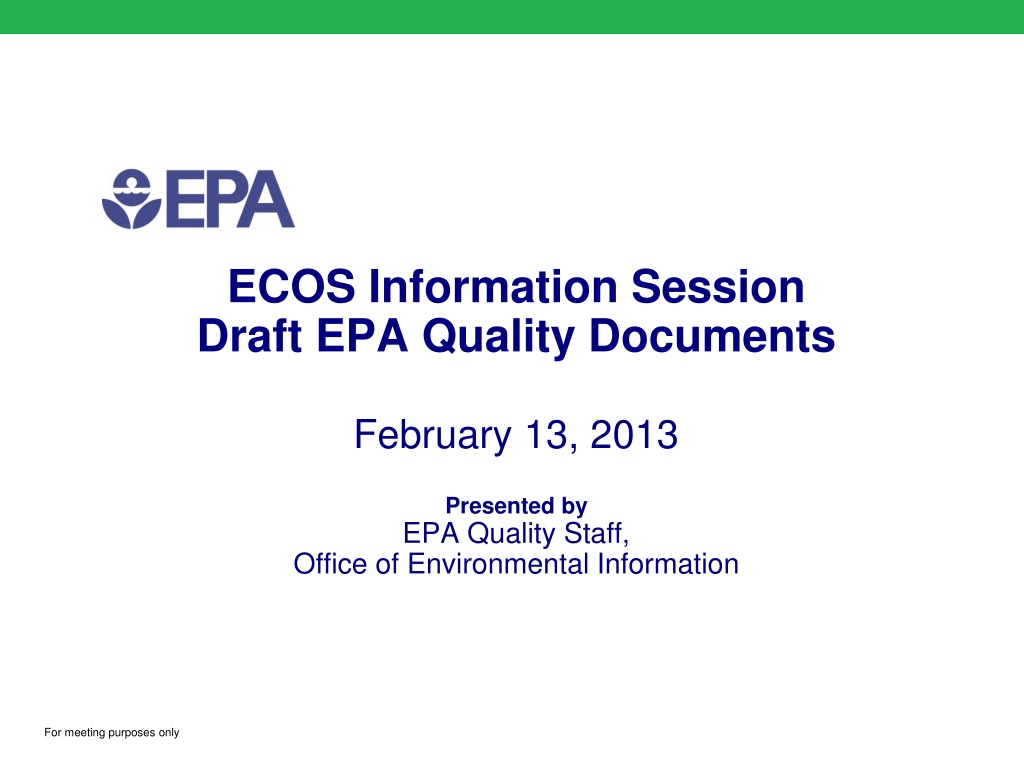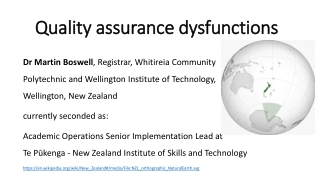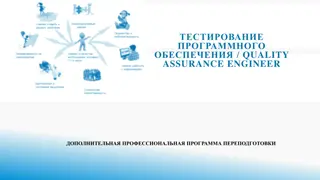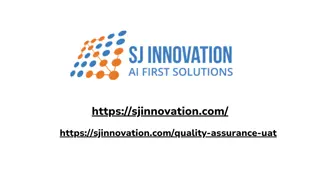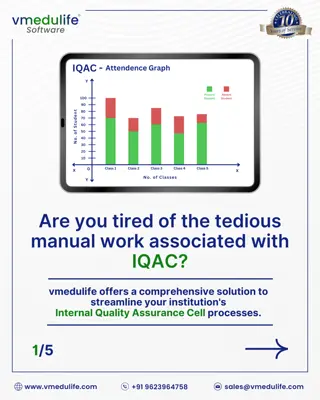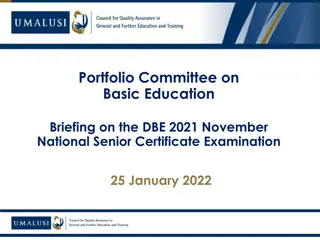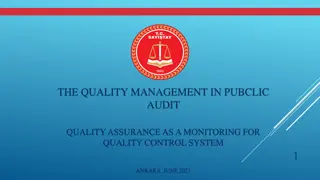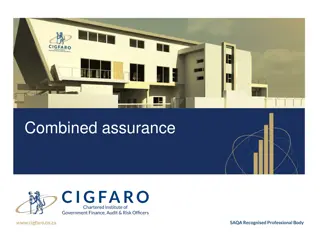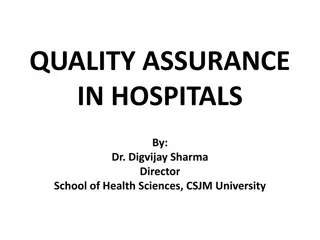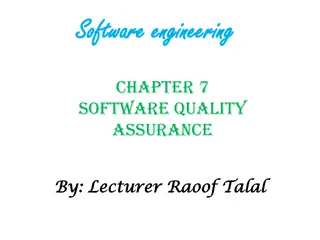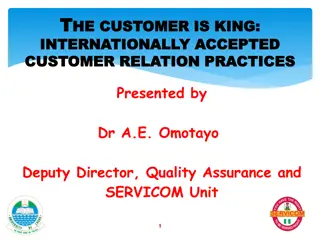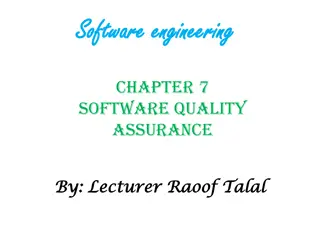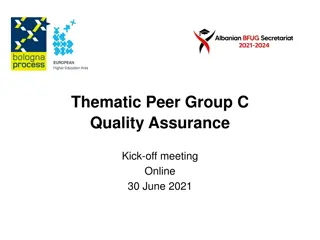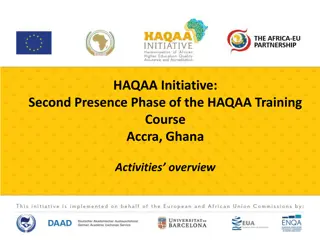Enhancing Quality Assurance Practices in EPA Documents
This information session by EPA Quality Staff on February 13, 2013, focuses on proposing a Quality Standard for external organizations. It emphasizes the importance of quality assurance in decision-making processes and the benefits of documenting QA procedures. The session also introduces the concept of a graded approach to QA, highlighting the significance of good documentation through Quality Management Plans and Quality Assurance Project Plans.
Download Presentation

Please find below an Image/Link to download the presentation.
The content on the website is provided AS IS for your information and personal use only. It may not be sold, licensed, or shared on other websites without obtaining consent from the author. Download presentation by click this link. If you encounter any issues during the download, it is possible that the publisher has removed the file from their server.
E N D
Presentation Transcript
ECOS Information Session Draft EPA Quality Documents February 13, 2013 Presented by EPA Quality Staff, Office of Environmental Information For meeting purposes only
Agenda Welcome Purpose of Information Session Overview Next Steps Questions 2
Purpose of Information Session To share the proposal to issue a Quality Standard for external organizations To provide general information about the proposed Quality documents and the rationale for the change To clarify the process for submitting questions and comments To provide the next steps in the process 3
Why the concern about quality? [Quality Assurance] ensures that the data relied upon for decision making is of known and documented quality and is based on sound scientific principles. EPA Administrator Lisa Jackson, May 2009 Quality Assurance refers to the systematic measurement, comparison with a standard, monitoring of processes and an associated feedback loop that confers error prevention. Wikipedia, January 2013 4
Benefits of documenting QA Documentation of processes and procedures reduces vulnerabilities and increases data reliability and defensible decisions: scientific data integrity justifiable resource expenditures transparent activities reliable and defensible decisions often results in burden reduction 5
The Graded Approach Excessive implementation of QA procedures and extensive documentation of protocols is not needed. QA activities and documentation should be proportionate with the: importance of the project or study resources available organizational management and structure intended use of the data potential risks of making wrong decisions 6
Good documentation Sound QA activities and good documentation are achieved through the use of Quality Management Plans (QMPs) and Quality Assurance Project Plans (QAPPs). A QMP reflects the activities and policies common to the organization. It is the umbrella under which individual projects are conducted. A QAPP contains the instructions by which individual projects are implemented. It documents exactly what needs to be done, how to do it, and when it will be done. 7
The Standards Proposed Quality Standards : Quality Standard for Environmental Data Collection, Production and Use by EPA Organizations CIO Standard 2106-S-01 Quality Standard for Environmental Data Collection, Production and Use by non-EPA Organizations CIO Standard 2106-S-02 They are similar but tailored to meet the needs of specific users. The correlation between them is very high and cover the same technical areas. The only difference between them is in internal procedural matters and EPA responsibilities. 8
Rationale for the Change Standards were developed to support the EPA Quality Policy (CIO 2106.0) issued in 2008 Standards are intended to incorporate and clarify the QA requirements for EPA organizations that are found in the EPA Order (CIO 2105.0) Standards are intended to incorporate and clarify the QA requirements for non EPA organizations found in external agreements 9
Replaces existing requirements When CIO Standard 2106-S-02 (External Standard) is issued, it will replace: QA/R-2 for Quality Management Plans (QMPs) QA/R-5 for QA Project Plans (QAPPs) Organizations continue to develop: QMPs QAPPs The External Standard continues the requirement for these Plans to be approved before environmental data are collected, produced or used. 10
How do they differ from existing? Compared with the existing requirements, these Standards are: reflective of current practices in quality more explicit in what is required consistent with EPA Quality Policy CIO 2106 better organized There will be very little change in practical application and will result in stronger QMPs and QAPPs 11
Coverage of the Standards Main document: Content of Quality Management Systems and Quality documentation Planning, implementation, and assessment processes Roles and responsibilities of management and staff Three Annexes: A. Requirements for QMPs (normative) B. Requirements for QAPPs (normative) C. Guidelines on Project Planning (informative) 12
Accompanying Handbooks Handbooks have been made for use with the Standards: Preparing Quality Management Plans Developing Quality Assurance Project Plans These non-mandatory advisory documents will: Address QA requirements found in the Standards Replace previous related guidance documents Provide greater clarity on relevant QA practices 13
Rationale for the Change EPA plans to issue a Guidance document to support the EPA Quality Policy (CIO 2106.0). QA Handbooks are intended to provide detailed practical advice on how to prepare the QA documents described in the Quality Standards 14
What do the Handbooks replace? These Handbooks replace: Unofficial advice on QMPs Guidance for QA Project Plans (EPA QA/G-5) These Handbooks are not stand-alone documents but intended to be used together with the Standards. References to specific parts of the Standards are included in each section of the Handbooks. 15
Are there large differences between Handbooks and the old Guidance? No. The QAPP Handbook incorporates all the material in the old Guidance (QA/G-5) and adds some more advice. QA/G-5 2A. Project Management 2B. Data Generation & Acquisition 2.3 Data Acquisition 2C. Assessment & Oversight 2D. Data Validation & Usability 3.1 Projects Using Existing Data 3.1 3.5 Evaluation of Existing Data QAPP Handbook 2.2 Project Management 2.4 Assessments 2.5 Evaluation of Usability but there are differences 16
Differences for example? The QAPP Handbook adds the following topics: qualitative comparisons to acceptance criteria evaluation of unconventional measurements qualitative and quantitative evaluations of usability use of existing data qualitative comparisons information on modeling use of data quality indicators use of quality control samples 17
How to submit questions and comments to EPA Go to www.regulations.gov Enter EPA HQ OEI 2012 0774 in the search line Add a check in the box Supporting & Related Material When leaving comments, go back to the results page click on Comment Now! Submit comments in the text box or by uploading a file 18
Next Steps Comments are due by February 28, 2012 EPA plans to post this presentation in the docket EPA plans to address all comments and questions received in the docket EPA response to questions and comments will be placed in the docket by April 15, 2013 EPA plans to issue the Quality Standards and QA Handbooks in April 2013. 19
QUESTIONS 20
